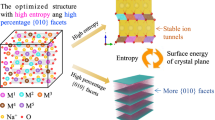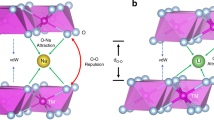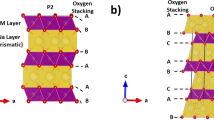Abstract
Sodium ion batteries, because of their sustainability attributes, could be an attractive alternative to Li-ion technology for specific applications. However, it remains challenging to design high energy density and moisture stable Na-based positive electrodes. Here, we report an O3-type NaLi1/3Mn2/3O2 phase showing anionic redox activity, obtained through a ceramic process by carefully adjusting synthesis conditions and stoichiometry. This phase shows a sustained reversible capacity of 190 mAh g−1 that is rooted in cumulative oxygen and manganese redox processes as deduced by combined spectroscopy techniques. Unlike many other anionic redox layered oxides so far reported, O3-NaLi1/3Mn2/3O2 electrodes do not show discernible voltage fade on cycling. This finding, rationalized by density functional theory, sheds light on the role of inter- versus intralayer 3d cationic migration in ruling voltage fade in anionic redox electrodes. Another practical asset of this material stems from its moisture stability, hence facilitating its handling and electrode processing. Overall, this work offers future directions towards designing highly performing sodium electrodes for advanced Na-ion batteries.
This is a preview of subscription content, access via your institution
Access options
Access Nature and 54 other Nature Portfolio journals
Get Nature+, our best-value online-access subscription
$29.99 / 30 days
cancel any time
Subscribe to this journal
Receive 12 print issues and online access
$259.00 per year
only $21.58 per issue
Buy this article
- Purchase on Springer Link
- Instant access to full article PDF
Prices may be subject to local taxes which are calculated during checkout






Similar content being viewed by others
Data availability
All relevant data are included in the article and its Supplementary Information.
References
Tarascon, J. M. The Li-ion battery: 25 years of exciting and enriching experiences. Electrochem. Soc. Interface 25, 79–83 (2016).
Yabuuchi, N., Kubota, K., Dahbi, M. & Komaba, S. Research development on sodium-ion batteries. Chem. Rev. 114, 11636–11682 (2014).
Hwang, J.-Y., Myung, S.-T. & Sun, Y.-K. Sodium-ion batteries: present and future. Chem. Soc. Rev. 46, 3529–3614 (2017).
Rozier, P. & Tarascon, J. M. Review—Li-rich layered oxide cathodes for next-generation Li-ion batteries: chances and challenges. J. Electrochem. Soc. 162, A2490–A2499 (2015).
Lu, Z. & Dahn, J. R. Understanding the anomalous capacity of Li/Li[NixLi(1/3−2x/3)Mn(2/3−x/3)]O2 cells using in situ X-ray diffraction and electrochemical studies. J. Electrochem. Soc. 149, A815–A822 (2002).
Thackeray, M. M., Johnson, C. S., Vaughey, J. T., Li, N. & Hackney., S. A. Advances in manganese-oxide ‘composite’ electrodes for lithium-ion batteries. J. Mater. Chem. 15, 2257–2267 (2005).
Xie, Y., Saubanère, M. & Doublet, M.-L. Requirements for reversible extra-capacity in Li-rich layered oxides for Li-ion batteries. Energy Environ. Sci. 10, 266–274 (2017).
Ben Yahia, M., Vergnet, J., Saubanère, M. & Doublet, M.-L. Unified picture of anionic redox in Li/Na-ion batteries. Nat. Mater. 18, 496–502 (2019).
Rozier, P. et al. Anionic redox chemistry in Na-rich Na2Ru1−ySnyO3 positive electrode material for Na-ion batteries. Electrochem. Commun. 53, 29–32 (2015).
Assadi, M. H. N., Okubo, M., Yamada, A. & Tateyama, Y. Oxygen redox promoted by Na excess and covalency in hexagonal and monoclinic Na2−xRuO3 polymorphs. J. Electrochem. Soc. 166, A5343–A5348 (2019).
Mortemard de Boisse, B. et al. Intermediate honeycomb ordering to trigger oxygen redox chemistry in layered battery electrode. Nat. Commun. 7, 11397 (2016).
Perez, A. J. et al. Strong oxygen participation in the redox governing the structural and electrochemical properties of Na-rich layered oxide Na2IrO3. Chem. Mater. 28, 8278–8288 (2016).
Zhang, X. et al. Manganese-based Na-rich materials boost anionic redox in high-performance layered cathodes for sodium-ion batteries. Adv. Mater. 31, 1807770 (2019).
House, R. A. et al. Superstructure control of first-cycle voltage hysteresis in O-redox cathodes. Nature 577, 502–508 (2020).
Maitra, U. et al. Oxygen redox chemistry without excess alkali-metal ions in Na2/3[Mg0.28Mn0.72]O2. Nat. Chem. 10, 288–295 (2018).
Du, K. et al. Exploring reversible oxidation of oxygen in a manganese oxide. Energy Environ. Sci. 9, 2575–2577 (2016).
Rong, X. et al. Anionic redox reaction-induced high-capacity and low-strain cathode with suppressed phase transition. Joule 3, 503–517 (2019).
Bai, X. et al. Anionic redox activity in a newly Zn-doped sodium layered oxide P2-Na2/3Mn1−yZnyO2 (0 < y < 0.23). Adv. Energy Mater. 8, 1802379 (2018).
Bai, X., Iadecola, A. & Tarascon, J.-M. & Rozier, P. Decoupling the effect of vacancies and electropositive cations on the anionic redox processes in Na based P2-type layered oxides.Energy Storage Mater. 31, 146–155 (2020).
Ma, C. et al. Exploring oxygen activity in the high energy P2-type Na0.78Ni0.23Mn0.69O2 cathode material for Na-ion batteries. J. Am. Chem. Soc. 139, 4835–4845 (2017).
Mariyappan, S., Wang, Q. & Tarascon, J. M. Will sodium layered oxides ever be competitive for sodium ion battery applications? J. Electrochem. Soc. 165, A3714–A3722 (2018).
Kim, D., Cho, M. & Cho, K. Rational design of Na(Li1/3Mn2/3)O2 operated by anionic redox reactions for advanced sodium-ion batteries. Adv. Mater. 29, 1701788 (2017).
Perez, A. J., Rousse, G. & Tarascon, J.-M. Structural instability driven by Li/Na competition in Na(Li1/3Ir2/3)O2 cathode material for Li-ion and Na-ion batteries. Inorg. Chem. 58, 15644–15651 (2019).
de la Llave, E. et al. Improving energy density and structural stability of manganese oxide cathodes for Na-Ion batteries by structural lithium substitution. Chem. Mater. 28, 9064–9076 (2016).
House, R. A. et al. What triggers oxygen loss in oxygen redox cathode materials? Chem. Mater. 31, 3293–3300 (2019).
Grey, C. P. & Lee, Y. J. Lithium MAS NMR studies of cathode materials for lithium-ion batteries. Solid State Sci. 5, 883–894 (2003).
Lee, Y. J. & Grey, C. P. Determining the lithium local environments in the lithium manganates LiZn0.5Mn1.5O4 and Li2MnO3 by analysis of the 6Li MAS NMR spinning sideband manifolds. J. Phys. Chem. B. 106, 3576–3582 (2002).
Shimoda, K. et al. Direct observation of layered-to-spinel phase transformation in Li2MnO3 and the spinel structure stabilised after the activation process. J. Mater. Chem. A. 5, 6695–6707 (2017).
Clément, R. J. et al. Direct evidence for high Na+ mobility and high voltage structural processes in P2-Nax[LiyNizMn1−y−z]O2 (x, y, z ≤ 1) cathodes from solid-state NMR and DFT calculations. J. Mater. Chem. A. 5, 4129–4143 (2017).
Cabana, J. et al. Study of the transition metal ordering in layered NaxNix/2Mn1–x/2O2(2/3 ≤ x ≤ 1) and consequences of Na/Li exchange. Inorg. Chem. 52, 8540–8550 (2013).
Assat, G. et al. Fundamental interplay between anionic/cationic redox governing the kinetics and thermodynamics of lithium-rich cathodes. Nat. Commun. 8, 2219 (2017).
Dai, K. et al. High reversibility of lattice oxygen redox quantified by direct bulk probes of both anionic and cationic redox reactions. Joule 3, 518–541 (2019).
Ito, A. et al. In situ X-ray absorption spectroscopic study of Li-rich layered cathode material Li[Ni0.17Li0.2Co0.07Mn0.56]O2. J. Power Sources 196, 6828–6834 (2011).
Dau, H., Liebisch, P. & Haumann, M. X-ray absorption spectroscopy to analyze nuclear geometry and electronic structure of biological metal centers—potential and questions examined with special focus on the tetra-nuclear manganese complex of oxygenic photosynthesis. Anal. Bioanal. Chem. 376, 562–583 (2003).
Vergnet, J., Saubanère, M., Doublet, M.-L. & Tarascon, J.-M. The structural stability of P2-layered Na-based electrodes during anionic redox. Joule 4, 420–434 (2020).
Berg, E. J. & Novák, P. Recent progress on Li-O2 batteries at PSI. in ECL Annual Report (Paul Scherrer Institut, 2012).
Lepoivre, F., Grimaud, A., Larcher, D. & Tarascon, J.-M. Long-time and reliable gas monitoring in Li-O2 batteries via a swagelok derived electrochemical cell. J. Electrochem. Soc. 163, A923–A929 (2016).
FullProf Suite (Full Prof Team, 2006); https://www.ill.eu/sites/fullprof/
Casas-Cabanas, M., Reynaud, M., Rikarte, J., Horbach, P. & Rodríguez-Carvajal, J. FAULTS: a program for refinement of structures with extended defects. J. Appl Cryst. 49, 2259–2269 (2016).
Avdeev, M. & Hester, J. R. ECHIDNA: a decade of high-resolution neutron powder diffraction at OPAL. J. Appl Cryst. 51, 1597–1604 (2018).
Rodríguez-Carvajal, J. Recent advances in magnetic structure determination by neutron powder diffraction. Phys. B. 192, 55–69 (1993).
Grandinetti, P. J. et al. Pure-absorption-mode lineshapes and sensitivity in two-dimensional dynamic-angle spinning NMR. J. Magn. Reson. A 103, 72–81 (1993).
Massiot, D. et al. Modelling one- and two-dimensional solid-state NMR spectra. Magn. Reson. Chem. 40, 70–76 (2002).
Rueff, J.-P. et al. The GALAXIES beamline at the SOLEIL synchrotron: inelastic X-ray scattering and photoelectron spectroscopy in the hard X-ray range. J. Synchrotron Rad. 22, 175–179 (2015).
Qiao, R. et al. High-efficiency in situ resonant inelastic X-ray scattering (iRIXS) endstation at the Advanced Light Source. Rev. Sci. Instrum. 88, 033106 (2017).
Briois, V. et al. ROCK: the new Quick-EXAFS beamline at SOLEIL. J. Phys. Conf. Ser. 712, 012149 (2016).
Kresse, G. & Hafner, J. Ab initio molecular dynamics for liquid metals. Phys. Rev. B. 47, 558–561 (1993).
Kresse, G. & Furthmüller, J. Efficiency of ab-initio total energy calculations for metals and semiconductors using a plane-wave basis set. Comput. Mater. Sci. 6, 15–50 (1996).
Perdew, J. P., Burke, K. & Ernzerhof, M. Generalized gradient approximation made simple. Phys. Rev. Lett. 77, 3865–3868 (1996).
Dudarev, S. L., Botton, G. A., Savrasov, S. Y., Humphreys, C. J. & Sutton, A. P. Electron-energy-loss spectra and the structural stability of nickel oxide: an LSDA+U study. Phys. Rev. B. 57, 1505–1509 (1998).
Acknowledgements
Q.W. thanks Renault S.A.S for PhD funding. J.-M.T. acknowledges the funding from European Research Council (ERC) (FP/2014)/ERC grant/project no. 670116-ARPEMA. A.M.A. and A.V.M. are grateful to Russian Science Foundation for the financial support (grant no. 20-43-01012). Access to the TEM facilities has been granted by Advance Imaging Core Facility of Skoltech. We thank the ROCK beamline at SOLEIL (Gif-sur-Yvette, France) for X-ray spectroscopy experiments (financed by the French National Research Agency (ANR) as a part of the ‘Investissements d’Avenir’ programme, reference ANR-10-EQPX-45; proposal nos. 20171234 and 20190596). HAXPES measurements were performed at GALAXIES beamline at the SOLEIL Synchrotron, France under proposal nos. 20171035 and 20190646. This work used resources of the Advanced Photon Source (11-BM), a US Department of Energy (DOE) Office of Science User Facility operated for the DOE Office of Science by Argonne National Laboratory under contract no. DE-AC02-06CH11357. NPD measurements were performed using the ECHIDNA instrument at ANSTO (Sydney, Australia). We are grateful to A. Iadecola for the help during XAS measurements. We thank S. Trabesinger, D. Giaume, M.F. Lagadec, W. Yin, A. Perez, B. Li, G. Yan, G. Assat and J. Vergnet for fruitful discussions. We acknowledge the staff of the MPBT (physical properties, low temperature) platform of Sorbonne Université for their support.
Author information
Authors and Affiliations
Contributions
Q.W., S.M. and J.-M.T. conceived the idea and designed the experiments. M.D. and B.P. performed NMR measurements. J.C./Y.-S.Y., R.D. and J.W./W.Y. performed and interpreted the XANES/extended X-ray absorption fine structure, HXAPES and mRIXS measurements. M.A. collected the NPD data, G.R. analysed and interpreted the SXRD and NPD patterns and performed the magnetic measurements while A.V.M. and A.M.A. collected and interpreted all the microscopy data. Last, L.Z. performed the OEMS measurements and M.C. supervised the project. M.-L.D. performed the theoretical calculations and contributed to the overall interpretation of the results. J.-M.T., A.M.A., S.M. and Q.W. wrote the paper, with contributions from all authors.
Corresponding author
Ethics declarations
Competing interests
The O3-Na(Li1/3Mn2/3)O2 material is patented by Renault (inventors Q.W., M.C., S.M. and J.-M.T.) with patent application number B19-5233FR (pending).
Additional information
Peer review information Nature Materials thanks Naoaki Yabuuchi and the other, anonymous, reviewer(s) for their contribution to the peer review of this work.
Publisher’s note Springer Nature remains neutral with regard to jurisdictional claims in published maps and institutional affiliations.
Supplementary information
Supplementary Information
Supplementary Figs. 1–30, Notes 1 and 2, Tables 1–9 and references.
Rights and permissions
About this article
Cite this article
Wang, Q., Mariyappan, S., Rousse, G. et al. Unlocking anionic redox activity in O3-type sodium 3d layered oxides via Li substitution. Nat. Mater. 20, 353–361 (2021). https://doi.org/10.1038/s41563-020-00870-8
Received:
Accepted:
Published:
Issue Date:
DOI: https://doi.org/10.1038/s41563-020-00870-8
This article is cited by
-
Fast-charge high-voltage layered cathodes for sodium-ion batteries
Nature Sustainability (2024)
-
Defective oxygen inert phase stabilized high-voltage nickel-rich cathode for high-energy lithium-ion batteries
Nature Communications (2023)
-
Solvation-enhanced electrolyte on layered oxide cathode tailoring even and stable CEI for durable sodium storage
Carbon Neutrality (2023)
-
Topologically protected oxygen redox in a layered manganese oxide cathode for sustainable batteries
Nature Sustainability (2021)



